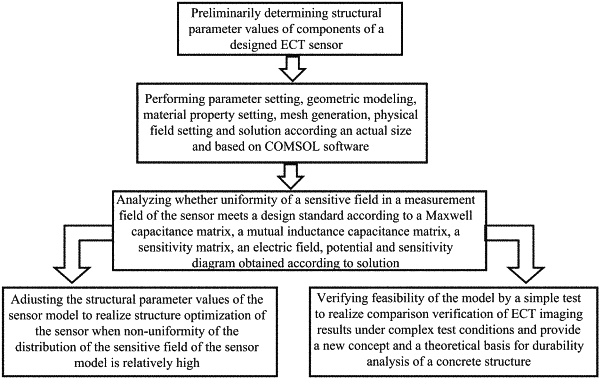| CPC G01N 27/223 (2013.01) [G01N 27/226 (2013.01); G01N 33/383 (2013.01)] | 2 Claims |

|
1. A method for optimizing a structure of an electrical capacitance tomography (ECT) sensor and analyzing an electromagnetic field, the method comprising steps of parameter setting, geometric setting, material setting, mesh generation, physical field setting, solution, sensor structure optimization and calculation of electromagnetic field distribution, wherein:
in parameter setting: sequentially inputting parameter values of components in a real diagram of the ECT sensor in a COMSOL software so as to change the parameter values quickly after modeling, and observing the electromagnetic field distribution in a measurement field of the ECT sensor when different design parameter values are given;
in geometric setting: establishing a finite element model of the ECT sensor according to the real diagram in the COMSOL software, and sequentially establishing a concrete component, a PVC layer, a copper electrode layer, a radial electrode layer, an air field, a shielding layer and an impurity region in the measurement field of the ECT sensor by taking a center of the finite element model of the ECT sensor as a center of a circle;
in material setting: setting a material of the measurement field of the ECT sensor as concrete, setting a material of the PVC layer as plastic, setting materials of the copper electrode layer and the shielding layer as copper, setting a material of the air field as air, and setting material properties of the impurity region according to setting requirements;
in mesh generation: setting a category of a mesh generation of a region of the finite element model of the ECT sensor as free triangular mesh generation, and setting sizes of maximum and minimum unit meshes according to set accuracy to further improve calculation accuracy;
in physical field setting: sequentially setting 12 electrodes of the finite element model of the ECT sensor as terminals, and setting parametric scanning so that electrode plates are excited in turn in a measurement process; observing the electromagnetic field distribution under different excitation conditions; and setting an external shielding device to be grounded;
in solution: calculating a Maxwell capacitance matrix, a mutual inductance capacitance matrix and a sensitivity matrix in the COMSOL software, and sequentially drawing detailed data diagrams of an electric field, potential and sensitivity, thereby preliminarily completing the calculation of the electromagnetic field distribution in the measurement field of the ECT sensor;
in sensor structure optimization: introducing an optimization function by utilizing the sensitivity obtained in the solution step, and obtaining a set of optimal parameter values through a factor rotation design test method or an orthogonal optimization design method, to realize parameter optimization of the sensor structure, improve uniformity of a sensitive field, and obtain an ECT sensor with an optimized structure; and
in calculation of electromagnetic field distribution: measuring relative dielectric constants of a concrete structure with different moisture contents through tests based on the electromagnetic field distribution in the measurement field of the ECT sensor, and correspondingly changing a dielectric constant of the measurement field of the ECT sensor in the finite element model of the ECT sensor to simulate a change of the electromagnetic field when the moisture content in the measurement field of the ECT sensor changes to realize an accurate analysis of the electromagnetic field when the moisture content in the concrete structure changes, thereby better explaining test results and providing a theoretical basis for a durability analysis of the concrete structure.
|